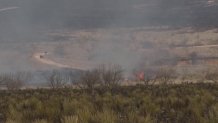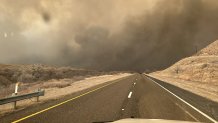What to know about Texas wildfires
- The Smokehouse Creek fire ignited in the Panhandle on Monday in rough terrain and unfavorable weather conditions.
- One death has been reported Officials warn of potentially large property losses.
- Texas Gov. Greg Abbott on Tuesday issued a disaster declaration for 60 counties.
A fast-moving wildfire burning through the Texas Panhandle has now become the largest blaze in state history after churning through a total of 1,075,000 acres across Texas and Oklahoma, forcing evacuations and triggering power outages as firefighters struggled to contain the widening swath of flames growing with alarming speed.
The Texas A&M Forest Service said Wednesday morning the sprawling blaze known as the Smokehouse Creek fire remained uncontained and had doubled in size overnight to nearly 800 square miles, or roughly 500,000 acres. By Wednesday afternoon, the fire was estimated to have spread to more than 1 million acres with 3% containment.
Texas A&M Forest Service said officials have responded to 56 wildfires burning more than 1,256,328 acres since Sunday.
Get Philly local news, weather forecasts, sports and entertainment stories to your inbox. Sign up for NBC Philadelphia newsletters.
As of Thursday morning, there are three additional active wildfires in the Texas panhandle: the Grape Vine Creek Fire in Gray County at 30,000 acres and 60% contained; the Windy Deuce Fire in Moore County at 142,000 acres and 30% contained; and the Magenta Fire in Oldham County at 2,500 acres and 65% contained.
“Strong winds and warm temperatures have resulted in grasses drying across many portions of Texas,” said Wes Moorehead, Texas A&M Forest Service Fire Chief. “As firefighters continue to suppress active fires, we urge Texans to be cautious with any outdoor activity that may cause a spark.”
Authorities warned that the damage to communities on the high plains could be extensive as flames blackened the landscape across a vast stretch of small towns and cattle ranches.
City of Borger Public Information Officer Brandon Strope confirms there has been one fatality from the Texas wildfires. No other information including the county was given.
With huge plumes of smoke billowing hundreds of feet in the air, officials warned residents of potentially large property losses.
Hemphill County Emergency Management Coordinator Bill Kendall described the charred terrain as being “like a moonscape. … It's just all gone.”
Kendall said about 40 homes were burned around the perimeter of the town of Canadian, but no buildings were lost inside the community.
“We started getting those losses in the dark, so we didn’t really know what we had until this morning until we could see,” he said.
The town of Fritch, with a population of less than 2,000, lost hundreds of homes in a 2014 fire and appeared to be hit hard again.
There was one point where we couldn’t see anything. I didn’t think we’d get out of it.
Greg Downey, describing his escape as flames bore down on his neighborhood
The people in that area are probably not "prepared for what they’re going to see if they pull into town,” Hutchinson County Emergency Management spokesperson Deidra Thomas said in a social media livestream. She compared the damage to a tornado.
The town remained unsafe for people to return, she said.
Tresea Rankin videotaped her own home in the town of Canadian as it burned.
“Thirty-eight years of memories, that’s what you were thinking,” Rankin said of watching the flames destroy her house. “Two of my kids were married there … But you know, it’s OK, the memories won’t go away.”
Authorities have not said what ignited the fires, but strong winds, dry grass and unseasonably warm temperatures fed the blazes. Near Borger, a community of about 13,000 people, emergency officials at one point late Tuesday answered questions from panicked residents on Facebook and told them to get ready to leave if they had not already.
“It was like a ring of fire around Borger. There was no way out … all four main roads were closed,” said Adrianna Hill, 28, whose home was within about a mile of the fire. She said a northern wind that blew the fire in the opposite direction “saved our butts.”
Republican Gov. Greg Abbott issued a disaster declaration for 60 counties. The encroaching flames caused the main facility that disassembles America’s nuclear arsenal to pause operations Tuesday night, but it was open for normal work on Wednesday.

The blazes tore through sparsely populated counties on the vast, high plains that are punctuated by cattle ranches and oil rigs. The main fire, known as the Smoke House Creek Fire, had grown to more than half the size of the state of Rhode Island. It is five times larger than on Monday when it began.
The weather forecast provided some hope for firefighters — cooler temperatures, less wind and possibly rain on Thursday. But for now, the situation was dire in some areas.
Sustained winds of up to 45 mph (72 kph), with gusts of up to 70 mph (113 kph), caused the fires that were spreading east to turn south, threatening new areas, forecasters said. But winds calmed down after a cold front came through Tuesday evening, said Peter Vanden Bosch, a meteorologist at the National Weather Service in Amarillo.
“Fortunately, the winds have weakened quite significantly,” Vanden Bosch said Wednesday. Breezy conditions were expected again Friday, and fire-friendly weather could return by the weekend, he said.
As the evacuation orders mounted Tuesday, county and city officials implored residents to turn on emergency alert services on their cellphones and be ready to evacuate immediately.
The Pantex plant, northeast of Amarillo, evacuated nonessential staff Tuesday night out of an “abundance of caution,” said Laef Pendergraft, a spokesperson for the National Nuclear Security Administration’s production office at Pantex. Firefighters remained in case of an emergency.
The plant has long been the main U.S. site for both assembling and disassembling atomic bombs. It completed its last new bomb in 1991 and has dismantled thousands since.
Pantex tweeted early Wednesday that the facility “is open for normal day shift operations” and that all personnel were to report for duty according to their assigned schedule.

As the fires raged Tuesday, evacuations were ordered in several towns in a swath northeast of Amarillo.
The Smokehouse Creek Fire spread from Texas into neighboring Roger Mills County in western Oklahoma, where officials encouraged people in the Durham area to flee. Officials did not know yet how large the fire was in Oklahoma.
An unrelated fire in Ellis County, Oklahoma, on the Oklahoma-Texas state line, led Tuesday to the evacuations of the towns of Shattuck and Gage. The evacuation order was lifted hours later, according to county Emergency Management Director Riley Latta. The fire had unknown origins and burned an estimated 47 square miles, according to the Oklahoma Department of Agriculture, Food and Forestry.
The weather service issued red-flag warnings and fire-danger alerts for several other states through the midsection of the country, as winds of over 40 mph (64 kph) combined with warm temperatures, low humidity and dry winter vegetation to make conditions ripe for wildfires.
In central Nebraska, a mower sparked a prairie fire that burned a huge swath of grassland roughly the size of the state's largest city of Omaha, state officials said Tuesday.
LARGEST WILDFIRES IN TEXAS HISTORY
- Smokehouse Creek of 2024, burning 1,000,000+ acres (active fire)
- East Amarillo Complex of 2006, burning 907,245 acres
- Big Country of 1998, burning 366,000 acres
- Perryton of 2017, burning 318,156 acres
2011 TEXAS WILDFIRES
In April 2011, during an extreme drought, four out-of-control wildfires burning in close proximity to each other were dubbed The Possum Kingdom Complex Fire. The fires scorched 126,000 acres of parched Texas ranch land and destroyed 168 homes and two churches.
Senior Meteorologist David Finfrock said in the NBC 5 docu-series Inside the Storm: Texas Burning, that at that time the period from August 2010 to July 2011 was the driest 12 consecutive months on record.
Later that summer, in August, a second fire erupted near the lake called the PK 101 Ranch fire. That fire burned more than 6,000 additional acres on the south side of the lake and destroyed nearly 40 more homes.
On Sept. 4, 2011, a massive wildfire erupted in Central Texas. The Bastrop County Complex Fire, east of Austin, became the most destructive wildfire in Texas history. More than 1,600 homes and structures were destroyed when 32,000 acres were scorched, including 96% of the 6,565-acre Bastrop State Park. Two people died in the fires.
During that 2011 fire season, the Texas A&M Forest Service said more than 31,000 fires burned more than four million acres across the state and destroyed 2,947 homes.

